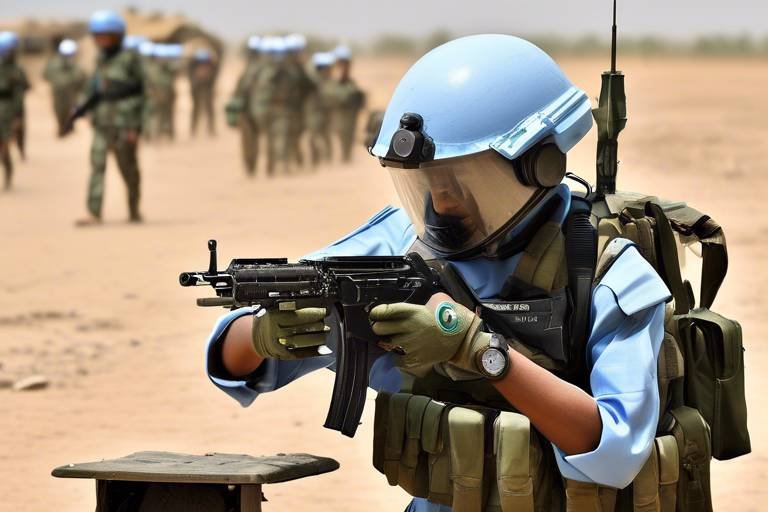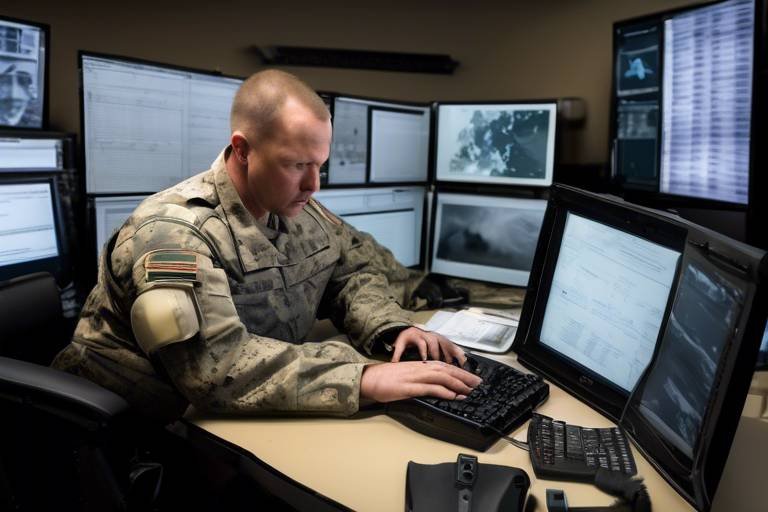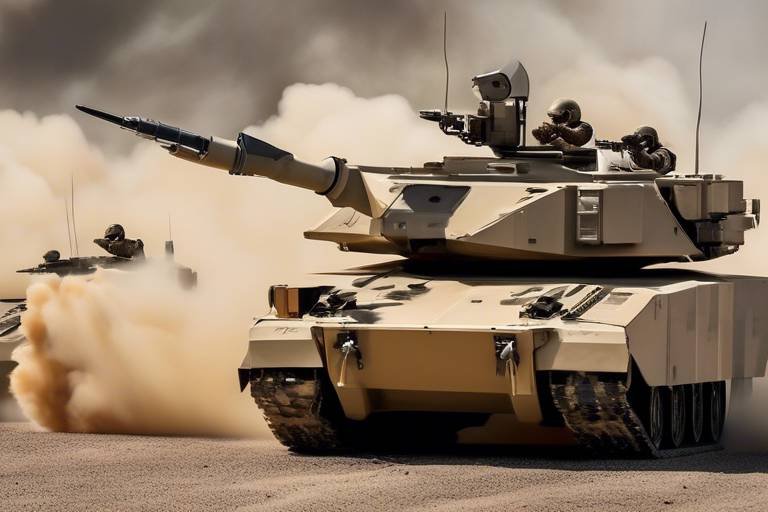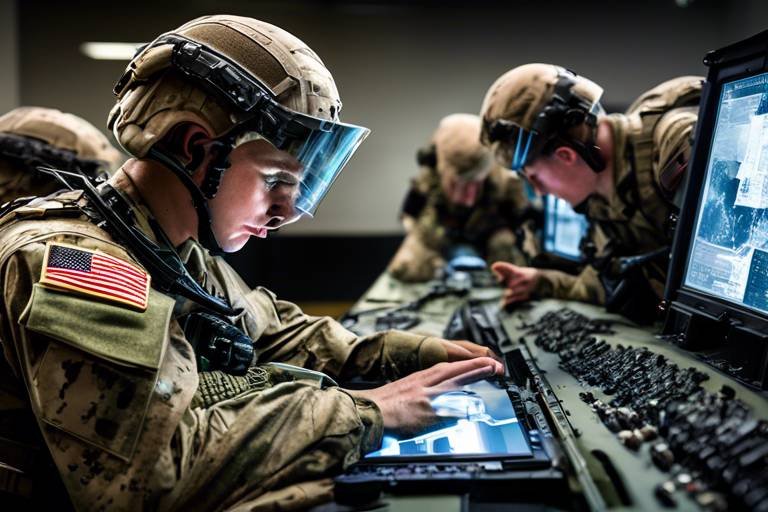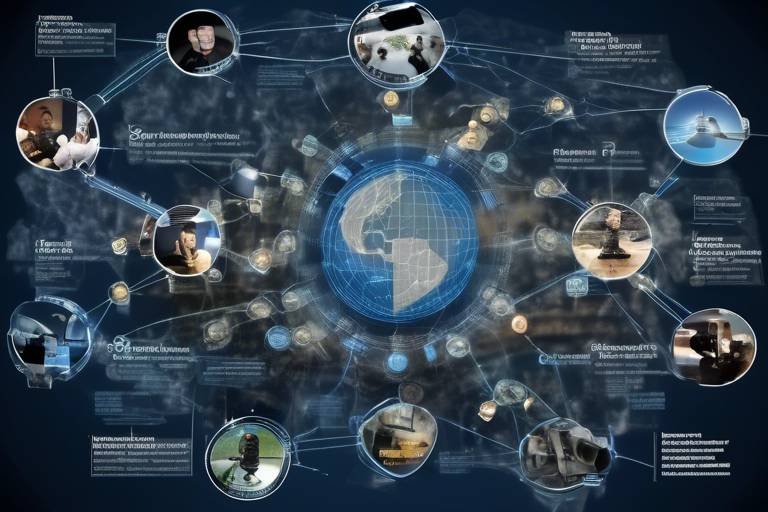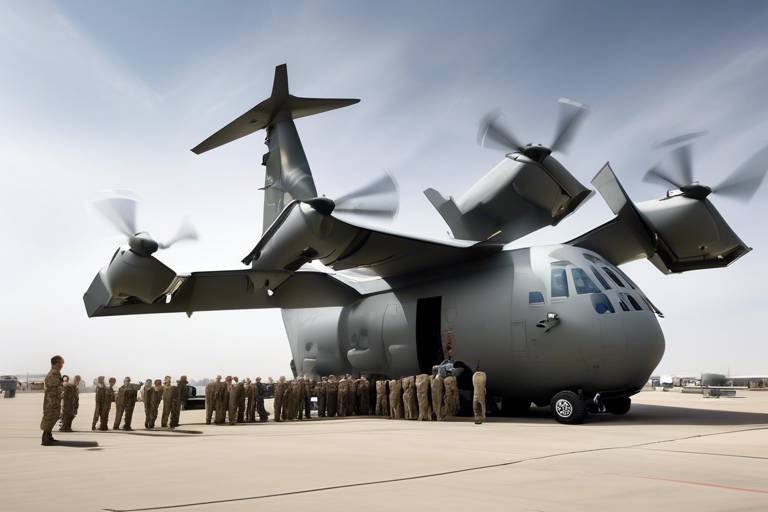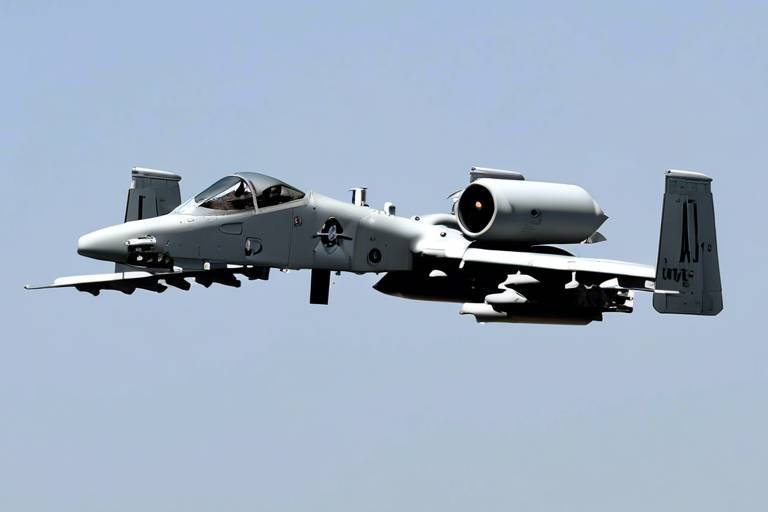Understanding the Role of Advanced Technologies in Peacekeeping
In today's world, the landscape of conflict is constantly evolving, and so too are the methods we use to address these challenges. Advanced technologies are not just a luxury; they are a necessity in modern peacekeeping operations. Imagine a world where peacekeepers can monitor conflict zones with the precision of a hawk soaring high above, gathering real-time data that informs their every move. This is not just a dream; it is the reality we are moving towards. Technologies such as drones, artificial intelligence, and advanced communication tools are transforming how peacekeeping missions are conducted, making them more efficient and effective than ever before.
As we delve deeper into this topic, it becomes clear that the integration of these technologies is not merely about innovation for its own sake. It is about enhancing the safety of personnel, improving the outcomes of missions, and ultimately, fostering a more stable environment in regions plagued by conflict. Think of it as equipping peacekeepers with a digital arsenal that allows them to respond swiftly and accurately to emerging threats. With the ability to analyze vast amounts of data, predict potential escalations, and communicate seamlessly across distances, these tools are redefining what it means to maintain peace.
However, the journey towards fully embracing these advanced technologies is not without its hurdles. There are ethical considerations, regulatory challenges, and the need for skilled operators that must be addressed. For instance, while drone surveillance can provide invaluable insights, it raises questions about privacy and the potential for misuse. Similarly, the deployment of artificial intelligence in conflict analysis necessitates a careful examination of bias and accountability. As we navigate these complexities, it is crucial to strike a balance between leveraging technology and upholding the principles of peacekeeping.
In the sections that follow, we will explore the evolution of peacekeeping technologies, the revolutionary impact of drone surveillance, the role of artificial intelligence in conflict analysis, and the importance of effective communication technologies. Each of these elements plays a vital role in enhancing the capabilities of peacekeepers on the ground, ensuring that they are not just reacting to situations but proactively preventing them. The future of peacekeeping lies in our ability to harness these advanced technologies, and together, we can pave the way for a more peaceful world.
- What are the main technologies used in peacekeeping? Technologies such as drones, artificial intelligence, and advanced communication systems are primarily used to enhance situational awareness and operational efficiency.
- How do drones improve peacekeeping operations? Drones provide real-time surveillance, allowing peacekeepers to monitor conflict zones effectively and make informed decisions.
- What ethical concerns arise from using AI in peacekeeping? AI can lead to issues related to accountability, algorithmic bias, and the potential reduction of human oversight in critical decision-making processes.
- What challenges do peacekeepers face with communication technologies? Connectivity issues, language barriers, and the need for training can hinder effective communication in remote or conflict-affected areas.

The Evolution of Peacekeeping Technologies
The landscape of peacekeeping has undergone a remarkable transformation over the decades, driven largely by the advent of advanced technologies. From the early days of traditional peacekeeping missions, which relied heavily on boots on the ground and face-to-face negotiations, we have now entered an era where cutting-edge tools and systems play a crucial role in enhancing mission effectiveness. This evolution is not just about adopting new gadgets; it's about fundamentally changing how peacekeepers operate in conflict zones.
Historically, peacekeeping efforts began with simple mechanisms such as observation posts and patrols. These methods, while effective at the time, were limited in scope and often hampered by the challenges of communication and data gathering. As the global landscape became more complex, the need for more sophisticated technologies emerged. This led to the introduction of communication systems that allowed for better coordination among peacekeeping forces, paving the way for more strategic and informed interventions.
In the late 20th century, the rise of satellite technology marked a significant milestone in peacekeeping operations. Satellites provided an unprecedented ability to monitor conflict zones from above, offering real-time imagery that could inform decision-makers about troop movements and potential threats. This shift not only enhanced situational awareness but also allowed peacekeepers to respond more swiftly to emerging crises.
Fast forward to today, and we see the integration of unmanned aerial vehicles (UAVs), commonly known as drones, which have further revolutionized peacekeeping. Drones are capable of conducting surveillance missions over vast areas, providing critical data that was once difficult to obtain. They can operate in challenging terrains and hostile environments, reducing the risk to human personnel while increasing the efficiency of information gathering. The deployment of drones has become a game-changer, enabling peacekeepers to maintain a constant watch over conflict zones.
Moreover, the evolution of peacekeeping technologies is not limited to aerial surveillance. The rise of artificial intelligence (AI) has introduced new dimensions to conflict analysis and decision-making. AI systems are now being employed to analyze vast amounts of data, predict potential escalations, and support strategic planning efforts. This capability allows peacekeeping forces to be proactive rather than reactive, addressing issues before they escalate into larger conflicts.
As we reflect on the journey of peacekeeping technologies, it becomes clear that each innovation has built upon the last, creating a sophisticated framework that enhances the effectiveness of peacekeeping missions. The integration of these advanced technologies has not only improved operational efficiency but has also fostered a greater understanding of the complexities involved in conflict resolution. The path forward will undoubtedly involve further advancements, as peacekeeping continues to adapt to the ever-evolving challenges of global peace and security.

Drone Surveillance in Peacekeeping
In the ever-evolving landscape of peacekeeping operations, drones have emerged as a transformative force, revolutionizing how missions are conducted in conflict zones. Imagine a bird's-eye view of a chaotic situation, where critical information is gathered in real-time, enabling peacekeepers to make informed decisions swiftly. This capability is not just a technological advancement; it's a game-changer that enhances situational awareness and operational effectiveness. Drones, equipped with advanced sensors and cameras, can monitor vast areas that would otherwise be challenging to assess, providing invaluable insights into the dynamics of conflict.
One of the most compelling aspects of drone surveillance is its ability to gather data without putting personnel at risk. Traditional methods of reconnaissance often involve ground patrols or manned aircraft, both of which expose individuals to potential danger. Drones, on the other hand, can operate from a safe distance, allowing peacekeepers to assess situations without the immediate threat of harm. This not only improves the safety of the personnel involved but also increases the overall efficiency of operations. For instance, a drone can cover an area of several kilometers in just a matter of minutes, significantly reducing the time required for reconnaissance missions.
Moreover, the data collected by drones can be processed and analyzed in real-time, offering peacekeeping forces a comprehensive understanding of the situation on the ground. This capability is particularly crucial in rapidly evolving scenarios where conditions can change in an instant. For example, during a peacekeeping mission in a volatile region, drones can provide live feeds that help commanders assess the situation, identify hotspots, and deploy resources effectively. This level of situational awareness is essential for making timely and strategic decisions that can prevent escalation and save lives.
However, the integration of drone technology in peacekeeping is not without its challenges. As we embrace this innovative tool, we must also address concerns related to privacy and regulation. The use of drones raises significant questions about surveillance ethics and the potential for misuse. Who has access to the data collected? How is it being used? These are critical issues that require careful consideration to ensure that drone operations uphold the principles of human rights and dignity.
Furthermore, the effective use of drones in peacekeeping missions necessitates skilled operators who are trained not only in piloting but also in understanding the complex dynamics of conflict zones. The technology itself is only as effective as the individuals who operate it. This underscores the need for ongoing training and support for peacekeeping personnel to maximize the benefits of drone surveillance.
In summary, drone surveillance is reshaping the landscape of peacekeeping operations, offering unparalleled advantages in terms of safety, efficiency, and situational awareness. As we continue to explore the potential of this technology, it is crucial to balance its benefits with ethical considerations and operational challenges. The future of peacekeeping may very well depend on our ability to harness the power of drones responsibly and effectively.
- What are the main benefits of using drones in peacekeeping? Drones provide real-time data, enhance situational awareness, reduce risks to personnel, and can cover large areas quickly.
- What challenges do drones face in peacekeeping? Challenges include privacy concerns, regulatory issues, and the need for skilled operators.
- How does drone surveillance improve decision-making in conflict zones? By providing timely and accurate data, drones help commanders make informed decisions that can prevent escalation and enhance mission effectiveness.

Benefits of Drone Technology
When we think about the battlefield of the future, it's hard not to picture drones soaring overhead, capturing vital information and providing critical support to peacekeeping missions. These unmanned aerial vehicles (UAVs) have transformed how peacekeepers operate, offering a multitude of benefits that can significantly enhance mission effectiveness. One of the most compelling advantages of drone technology is its ability to gather real-time data, which is crucial for situational awareness in conflict zones. Imagine being able to see what's happening on the ground from a bird's-eye view, allowing commanders to make informed decisions swiftly.
Moreover, drones are cost-effective compared to traditional methods of surveillance. Deploying manned aircraft or ground patrols can be expensive and resource-intensive. In contrast, drones can cover vast areas without the same financial burden, allowing peacekeeping forces to allocate their resources more efficiently. This efficiency is not just about saving money; it also means that more funds can be directed towards humanitarian efforts, infrastructure rebuilding, and other essential services in conflict-affected areas.
Another significant benefit is the reduced risk to personnel. In high-risk environments, sending in human operatives can be dangerous. Drones can perform reconnaissance missions, assess threats, and gather intelligence without putting lives on the line. This is particularly important in volatile regions where the safety of peacekeepers is paramount. By utilizing drones, missions can minimize exposure to potential harm while still obtaining critical information.
Furthermore, the ability of drones to operate in remote and hard-to-reach areas is a game changer. Traditional surveillance methods often struggle in challenging terrains or during adverse weather conditions. Drones, however, can navigate these obstacles with ease, providing peacekeepers with a continuous flow of information, which is essential for timely intervention and support. This capability is especially vital in regions where ground access is limited or where traditional communication lines may be down.
In summary, the integration of drone technology into peacekeeping operations offers numerous advantages, including:
- Real-time data collection for enhanced situational awareness.
- Cost-effectiveness that allows for better resource allocation.
- Reduced risk to personnel by minimizing human exposure to danger.
- Operational flexibility in challenging terrains and adverse conditions.
As we continue to explore the role of advanced technologies in peacekeeping, it's clear that drones are not just a passing trend; they represent a critical evolution in how peacekeeping missions are conducted. The benefits they bring to the table are undeniable, paving the way for more effective and safer operations in some of the world's most challenging environments.
Q: How do drones improve situational awareness in peacekeeping operations?
A: Drones provide real-time aerial surveillance, allowing peacekeepers to monitor conflict zones from above, which enhances their understanding of the situation on the ground and aids in decision-making.
Q: Are drones cost-effective compared to traditional surveillance methods?
A: Yes, drones are generally more cost-effective as they require less financial and logistical resources compared to manned aircraft, making them a practical choice for peacekeeping missions.
Q: What are the risks associated with using drones in conflict zones?
A: While drones reduce the risk to personnel, challenges such as privacy concerns, potential misuse, and the need for skilled operators still exist and must be managed carefully.
Q: Can drones operate in adverse weather conditions?
A: Many modern drones are designed to withstand various weather conditions, allowing them to function effectively in environments where traditional methods might fail.

Challenges and Limitations
Despite the remarkable advantages that drone technology brings to peacekeeping operations, it is essential to acknowledge the that accompany its use. One significant concern is the issue of privacy. Drones equipped with high-resolution cameras can inadvertently capture images of civilians and their private lives, leading to potential violations of privacy rights. This raises ethical questions about the extent to which surveillance should be conducted in conflict zones, where the line between security and privacy can become blurred.
Moreover, the integration of drone technology into peacekeeping missions is often hindered by regulatory issues. Different countries have varying laws regarding drone operations, which can complicate international missions. Peacekeeping forces may find themselves navigating a complex web of regulations that restrict where and how drones can be deployed, potentially limiting their effectiveness. Additionally, the need for skilled operators cannot be overstated. While drones can automate many tasks, they still require trained personnel to operate and maintain them. This necessitates investment in training and resources that some missions may not have readily available.
Furthermore, the reliance on technology introduces a layer of vulnerability. Drones can be susceptible to hacking or jamming, which can compromise their functionality and the safety of the mission. In hostile environments, where adversaries may have access to counter-drone measures, the effectiveness of this technology can be significantly reduced. This technological dependence can lead to a false sense of security among peacekeepers, who may underestimate the complexities of the operational environment.
In summary, while drone technology has the potential to enhance peacekeeping operations dramatically, it is crucial for organizations to address these challenges proactively. By developing comprehensive strategies that consider privacy, regulatory compliance, operator training, and technological vulnerabilities, peacekeeping missions can maximize the benefits of drones while mitigating their risks.
- What are the main benefits of using drones in peacekeeping? Drones offer real-time surveillance, cost-effectiveness, and reduced risk to personnel, enabling peacekeepers to gather vital information quickly and efficiently.
- How do privacy concerns affect drone usage in conflict zones? Drones can inadvertently capture private information about civilians, raising ethical questions about surveillance practices in sensitive areas.
- What regulatory issues can impact drone operations? Different countries have varying laws regarding drone use, which can complicate international missions and limit operational effectiveness.
- Are drones vulnerable to attacks? Yes, drones can be hacked or jammed, which poses risks to their functionality and the safety of peacekeeping missions.

Artificial Intelligence in Conflict Analysis
Artificial intelligence (AI) is rapidly transforming the landscape of conflict analysis, providing peacekeeping forces with powerful tools to understand and predict the dynamics of conflict zones. Imagine having a virtual assistant that can sift through mountains of data in seconds, identifying patterns and trends that human analysts might overlook. This is the essence of AI in conflict analysis—leveraging vast datasets to derive actionable insights that can inform strategic decisions on the ground.
One of the most significant advantages of AI is its ability to process and analyze data at an unprecedented scale. Peacekeeping missions often involve complex environments where multiple factors contribute to instability. AI algorithms can analyze data from various sources, including social media, satellite imagery, and historical conflict data, to identify potential flashpoints before they escalate into violence. This capability is crucial for peacekeeping commanders who need to make informed decisions quickly, often in high-pressure situations.
Furthermore, AI-powered decision support systems are becoming integral to mission planning and execution. These systems utilize predictive analytics to forecast potential escalations in violence, allowing peacekeeping forces to act proactively rather than reactively. For example, by analyzing historical data related to ethnic tensions, economic instability, and past conflicts, AI can help predict where and when unrest is likely to occur, enabling peacekeepers to allocate resources more effectively.
However, the integration of AI into conflict analysis is not without its challenges. Ethical considerations loom large, as the deployment of AI raises questions about accountability and bias. If an AI system makes a recommendation that leads to a significant operational decision, who is responsible for that decision? Moreover, the algorithms used in AI systems can sometimes reflect the biases present in the data they are trained on, potentially leading to skewed analyses and unintended consequences in conflict zones.
To navigate these challenges, it is essential for peacekeeping organizations to establish clear guidelines and frameworks for the ethical use of AI. This includes ensuring transparency in the algorithms used and maintaining human oversight in decision-making processes. Striking the right balance between leveraging AI's capabilities and upholding ethical standards is critical to the successful integration of these technologies in peacekeeping operations.
In conclusion, AI represents a groundbreaking advancement in conflict analysis, offering peacekeeping forces enhanced capabilities to anticipate and respond to crises. As technology continues to evolve, the potential for AI to revolutionize peacekeeping operations is immense, but it also necessitates careful consideration of the ethical implications involved. The future of conflict analysis will undoubtedly be shaped by AI, and it is up to us to ensure that this powerful tool is used responsibly and effectively in the pursuit of peace.
- What role does AI play in conflict analysis? AI helps analyze vast amounts of data to identify patterns and predict potential escalations in conflict zones.
- Are there ethical concerns associated with using AI in peacekeeping? Yes, issues such as accountability, bias in algorithms, and the need for human oversight are critical considerations.
- How can AI improve decision-making in peacekeeping missions? AI provides predictive analytics and valuable insights that enhance the decision-making processes of peacekeeping commanders.
- What data sources can AI analyze for conflict prediction? AI can analyze data from social media, satellite imagery, historical conflict data, and more to inform conflict analysis.

AI-Powered Decision Support Systems
In the realm of peacekeeping, the integration of Artificial Intelligence (AI) into decision support systems is nothing short of revolutionary. Imagine having a tool that not only processes vast amounts of data but also makes sense of it, providing actionable insights at lightning speed. This is precisely what AI-powered decision support systems offer to peacekeeping commanders. By analyzing historical data, real-time intelligence, and various conflict indicators, these systems can predict potential escalations and suggest strategic responses, thereby enhancing mission effectiveness.
One of the most compelling aspects of AI in this context is its ability to turn chaos into clarity. In conflict zones, where information can be overwhelming and often contradictory, AI can sift through noise and identify patterns that human analysts might miss. For instance, AI algorithms can analyze social media trends, satellite imagery, and local reports to assess the mood of the population, which is crucial for anticipating unrest. This capability not only aids in planning but also helps in deploying resources more effectively, ensuring that peacekeepers are in the right place at the right time.
Furthermore, AI-powered systems can facilitate real-time decision-making. Imagine a scenario where a peacekeeping unit receives reports of escalating tensions in a particular region. An AI system can quickly analyze the situation, considering factors such as troop movements, historical conflict data, and even weather conditions, to recommend a course of action. This rapid analysis can be the difference between a peaceful resolution and a violent outbreak. The ability to make informed decisions swiftly is invaluable in the unpredictable landscape of conflict zones.
However, the implementation of AI in decision support systems is not without its challenges. One major concern is the potential for bias in algorithms. If the data fed into these systems is skewed or incomplete, the insights generated may lead to flawed decisions. Therefore, it is crucial to ensure that the data used is representative and that there are mechanisms in place to regularly evaluate the performance of these AI systems. Additionally, human oversight remains essential; while AI can enhance decision-making, it should not replace the critical judgment and experience of peacekeeping personnel.
To further illustrate the impact of AI-powered decision support systems in peacekeeping, consider the following table that highlights key features and benefits:
| Feature | Benefit |
|---|---|
| Data Integration | Combines information from various sources for a comprehensive view. |
| Predictive Analytics | Forecasts potential conflict scenarios to aid in proactive planning. |
| Real-time Insights | Provides immediate recommendations based on current data. |
| Resource Allocation | Optimizes deployment of personnel and equipment in response to threats. |
In conclusion, AI-powered decision support systems represent a significant leap forward in the realm of peacekeeping. By harnessing the power of AI, peacekeeping forces can make better-informed decisions, anticipate challenges, and ultimately, save lives. As technology continues to evolve, the potential for these systems to enhance peacekeeping operations will only grow. It is imperative, however, that we approach this technology with a critical eye, ensuring that ethical considerations are at the forefront of its deployment.
- What is an AI-powered decision support system?
It is a technology that uses artificial intelligence to analyze data and provide actionable insights for decision-making in various contexts, including peacekeeping. - How does AI improve decision-making in peacekeeping?
AI enhances decision-making by analyzing large datasets quickly, identifying patterns, and providing real-time insights that help commanders make informed choices. - Are there risks associated with using AI in peacekeeping?
Yes, potential risks include algorithmic bias, reliance on incomplete data, and the need for human oversight to ensure ethical decision-making.

Ethical Considerations of AI Use
The integration of artificial intelligence (AI) in peacekeeping operations is a double-edged sword, offering remarkable advancements while simultaneously raising significant ethical questions. As we embrace the potential of AI to enhance decision-making and operational efficiency, we must also grapple with the implications of its use. One of the foremost concerns revolves around accountability. When AI systems make critical decisions, who is responsible for the outcomes? Is it the developers, the military leaders, or the AI itself? This ambiguity can lead to troubling scenarios where no one is held accountable for errors, especially in high-stakes situations like conflict resolution.
Moreover, there is the issue of algorithmic bias. AI systems learn from historical data, which can inadvertently reflect societal prejudices. If these biases are not carefully managed, AI could reinforce existing inequalities or make flawed predictions about conflict dynamics. For instance, if an AI system is trained on data that disproportionately represents certain groups, it might misinterpret the behaviors of others, leading to misguided strategies that could escalate tensions rather than alleviate them.
Another pressing ethical consideration is the impact of automation on human oversight. As AI takes on more responsibilities in conflict analysis and decision-making, there is a risk that human judgment may be sidelined. While AI can process vast amounts of data quickly, it lacks the nuanced understanding that comes from human experience and empathy. This raises the question: should we trust machines to make decisions that could affect lives? The balance between leveraging AI's capabilities and maintaining human oversight is delicate and requires careful navigation.
In addition to these concerns, transparency in AI operations is crucial. Peacekeeping missions thrive on trust and cooperation, and the use of opaque AI systems can erode this trust. Stakeholders must understand how decisions are made, what data is used, and the rationale behind AI-driven recommendations. This transparency is vital not only for accountability but also for fostering collaboration among international partners and local communities.
To address these ethical considerations effectively, a framework for responsible AI use in peacekeeping is essential. This framework should include:
- Clear accountability structures that delineate responsibility for AI-driven decisions.
- Bias mitigation strategies to ensure fairness in AI algorithms.
- Human-in-the-loop mechanisms that maintain human oversight in critical decision-making processes.
- Transparency protocols that provide insights into AI functionality and decision-making criteria.
In conclusion, while AI presents transformative possibilities for peacekeeping, it is imperative that we approach its integration with a critical eye. By addressing these ethical considerations, we can harness the power of AI while safeguarding the values of accountability, fairness, and human oversight that are essential in peacekeeping missions.
Q1: What are the main ethical concerns regarding AI in peacekeeping?
A1: The primary concerns include accountability for AI decisions, algorithmic bias, the impact of automation on human oversight, and the need for transparency in AI operations.
Q2: How can bias in AI systems be mitigated?
A2: Bias can be mitigated by using diverse and representative training data, implementing bias detection algorithms, and regularly auditing AI systems for fairness.
Q3: Why is human oversight important in AI decision-making?
A3: Human oversight ensures that decisions consider context, ethics, and empathy, which AI systems may lack, thus preventing potential negative outcomes.
Q4: What role does transparency play in AI deployment in peacekeeping?
A4: Transparency helps build trust among stakeholders, allowing them to understand how AI systems operate and the reasoning behind their decisions.

Communication Technologies in Peacekeeping
Effective communication is the backbone of successful peacekeeping operations. In the chaotic environment of conflict zones, where every second counts, the ability to relay information swiftly and accurately can mean the difference between mission success and failure. Advanced communication technologies have emerged as game-changers in this arena, enabling peacekeepers to coordinate their efforts seamlessly, share critical intelligence, and respond to evolving situations in real-time. Imagine being in a remote area, surrounded by uncertainty, yet having the power to connect instantly with your team miles away. This is the reality that modern communication tools bring to the forefront.
Mobile communication technologies, in particular, have transformed the landscape of peacekeeping missions. With the advent of smartphones and satellite communication devices, peacekeepers can now maintain constant contact, ensuring that vital information flows freely. These tools allow for instant messaging, video calls, and even live streaming of situations as they unfold. For instance, a peacekeeper in the field can send a video feed of a potential threat to command headquarters, allowing for rapid assessment and response. This level of connectivity enhances operational efficiency and situational awareness, which are crucial in high-stakes environments.
However, the integration of these technologies is not without its challenges. In many remote areas, connectivity issues can hinder communication efforts. Poor network coverage or complete lack of signal can isolate peacekeeping units, making it difficult to coordinate actions or request support. Moreover, language barriers can complicate communication, especially in multinational missions where peacekeepers come from diverse backgrounds. To mitigate these challenges, ongoing training and the use of translation technologies are essential. Peacekeeping forces must be equipped not only with the right tools but also with the skills to use them effectively.
As we look toward the future, the potential for communication technologies in peacekeeping is vast. Innovations such as augmented reality (AR) and virtual reality (VR) could revolutionize training and operational planning. Imagine a scenario where peacekeepers can simulate complex environments and practice their responses in real-time through VR, enhancing their preparedness for actual missions. Additionally, the use of artificial intelligence in communication systems could streamline information sharing and improve decision-making processes. By analyzing data patterns and predicting communication needs, AI can facilitate smoother operations and enhance the overall effectiveness of peacekeeping missions.
In conclusion, communication technologies play an indispensable role in modern peacekeeping. They not only enhance the ability to coordinate and respond but also foster a sense of unity among diverse teams working towards a common goal. As these technologies continue to evolve, they will undoubtedly shape the future of peacekeeping, making it more effective and responsive to the complexities of conflict resolution.
- What are the main communication technologies used in peacekeeping?
Peacekeeping missions utilize a variety of communication technologies, including mobile phones, satellite communication devices, and secure messaging applications to ensure real-time communication among team members.
- How do language barriers affect communication in peacekeeping?
Language barriers can lead to misunderstandings and miscommunications, which can hinder mission effectiveness. Training in language skills and the use of translation technologies are essential to overcome these challenges.
- What role does AI play in enhancing communication in peacekeeping?
AI can analyze communication patterns and predict needs, helping to streamline information sharing and improve decision-making processes in peacekeeping operations.
- What are the challenges faced by peacekeepers in remote areas?
Challenges include poor connectivity, lack of signal, and environmental factors that can disrupt communication, making it vital for peacekeepers to have contingency plans and alternative communication methods.

Mobile Communication Tools
In the ever-evolving landscape of peacekeeping operations, have emerged as a game-changer, fundamentally altering how peacekeepers interact and coordinate in the field. Imagine being in a remote conflict zone, where every second counts, and having the ability to communicate instantly with your team, no matter where they are. This is the reality that modern mobile technologies bring to peacekeeping missions, enhancing not just communication but also operational effectiveness.
The integration of smartphones, tablets, and specialized communication apps allows peacekeepers to share vital information in real time. For instance, when a situation escalates, peacekeepers can quickly send alerts, share location data, and even transmit images or videos to command centers. This immediacy is crucial; it enables commanders to make informed decisions based on up-to-date information, which can ultimately save lives and mitigate conflict.
Moreover, mobile communication tools facilitate the use of collaborative platforms where peacekeeping personnel can engage in discussions, share intelligence, and strategize on-the-go. These platforms often come with features such as secure messaging, video conferencing, and document sharing, ensuring that all team members are on the same page, regardless of their physical location. This is particularly important in peacekeeping missions where teams are often spread across vast areas, and effective communication can mean the difference between success and failure.
However, while the benefits are substantial, it's essential to acknowledge the challenges that come with mobile communication in conflict zones. Issues such as connectivity can pose significant hurdles; in many remote areas, reliable internet service is scarce, making it difficult to maintain communication. Furthermore, language barriers can complicate interactions among international peacekeeping forces, necessitating the use of translation tools or multilingual personnel to ensure clarity.
In summary, mobile communication tools are indispensable in modern peacekeeping operations. They not only enhance coordination and information sharing but also empower peacekeepers to respond swiftly to dynamic situations. As technology continues to advance, the effectiveness of these tools will likely improve, paving the way for even more innovative solutions to communication challenges in the field.
- What role do mobile communication tools play in peacekeeping?
Mobile communication tools facilitate real-time communication, coordination, and information sharing among peacekeepers, enhancing operational efficiency. - What are some challenges faced with mobile communication in conflict zones?
Challenges include connectivity issues, language barriers, and the need for secure communication channels to protect sensitive information. - How do mobile tools improve decision-making in peacekeeping?
They allow for instant sharing of critical information, enabling commanders to make informed decisions quickly based on real-time data.

Challenges in Communication
Effective communication is the backbone of successful peacekeeping operations. However, there are numerous challenges that peacekeepers face when trying to communicate in conflict zones. One of the most significant hurdles is the connectivity issues that arise in remote and war-torn areas. In many instances, the infrastructure is severely damaged or completely non-existent, making it difficult for peacekeepers to establish reliable communication channels. Imagine trying to send a message through a broken telephone line; that’s exactly what it feels like when technology fails in the field.
Moreover, language barriers can create a significant gap in communication. Peacekeeping forces often come from diverse backgrounds and nationalities, leading to a situation where the linguistic diversity can complicate interactions with local populations. This not only hampers the ability to gather crucial information but can also lead to misunderstandings that might escalate tensions rather than resolve them. For instance, a simple miscommunication can turn a cooperative dialogue into a heated confrontation.
Additionally, the security environment can pose a challenge to communication. In high-risk areas, peacekeepers need to be cautious about the information they share, as it can compromise their safety and the mission's objectives. They often have to balance the need for transparent communication with the necessity of operational security. This delicate balance can lead to a reluctance to share information, which is counterproductive in a field where timely and accurate information is crucial.
Furthermore, the lack of standardized communication protocols among different peacekeeping units can lead to confusion and inefficiencies. Each unit might use different technologies and methods for communication, resulting in a fragmented approach. To illustrate this, consider a scenario where one unit relies on satellite phones while another uses radio systems; without a common platform, coordinating efforts becomes a logistical nightmare.
To summarize, the challenges in communication during peacekeeping missions are multifaceted and can significantly hinder operational success. Addressing these issues requires a concerted effort to improve infrastructure, establish common communication protocols, and provide language training to peacekeepers. Only by overcoming these barriers can peacekeeping missions hope to achieve their goals effectively.
- What are the main communication challenges in peacekeeping?
The main challenges include connectivity issues, language barriers, security concerns, and lack of standardized communication protocols.
- How do language barriers affect peacekeeping operations?
Language barriers can lead to misunderstandings, complicate interactions with local populations, and hinder the gathering of crucial information.
- What can be done to improve communication in peacekeeping missions?
Improvements can be made by enhancing infrastructure, establishing common communication protocols, and providing language training for peacekeepers.

The Future of Technology in Peacekeeping
As we gaze into the crystal ball of peacekeeping operations, it becomes increasingly clear that the future is intertwined with technology in ways we are only beginning to understand. Imagine a world where conflict zones are monitored by a network of drones, where artificial intelligence (AI) analyzes data in real-time to predict potential threats, and where peacekeepers communicate seamlessly, regardless of location. This vision is not just a distant dream; it is a rapidly approaching reality that promises to enhance the effectiveness of peacekeeping missions.
One of the most exciting prospects lies in the integration of machine learning and big data analytics. These technologies can sift through vast amounts of information, identifying patterns and providing insights that human analysts might miss. For instance, AI can analyze social media trends to gauge public sentiment in conflict areas, helping commanders make informed decisions based on real-time data. This capability to predict escalations before they occur could be a game-changer, allowing peacekeepers to intervene proactively rather than reactively.
Moreover, the use of augmented reality (AR) and virtual reality (VR) in training peacekeepers is set to revolutionize how personnel prepare for their missions. Imagine soldiers donning VR headsets that simulate real-world scenarios, allowing them to practice their responses in a controlled environment. This immersive training can enhance their readiness and adaptability in the field, ultimately leading to more successful missions.
However, as we embrace these advancements, it is essential to consider the ethical implications that come with them. The deployment of autonomous systems raises questions about accountability. Who is responsible if a drone makes a mistake? Furthermore, the potential for bias in AI algorithms must be addressed to ensure that technology serves all parties equitably in conflict zones. Ongoing discussions and regulations will be crucial in navigating these challenges as we move forward.
In addition to the technological innovations, the future of peacekeeping will also require a cultural shift within organizations. Embracing technology means fostering a mindset that values innovation and adaptability. Peacekeeping missions must be willing to invest in continuous training and development to equip personnel with the skills needed to leverage these advanced tools effectively. This cultural change will play a pivotal role in the successful integration of technology into peacekeeping operations.
As we look ahead, it is clear that the future of technology in peacekeeping is not just about adopting new tools but about creating a holistic approach that combines human insight with technological prowess. The potential for improved coordination, enhanced situational awareness, and more effective conflict resolution is immense. To harness this potential, peacekeeping organizations must remain agile, continuously evaluating and integrating new technologies while addressing the ethical considerations that accompany them.
- What role will AI play in future peacekeeping operations? AI is expected to enhance decision-making processes by providing predictive analytics and insights, which can help peacekeepers anticipate and mitigate conflicts.
- How will communication technologies evolve in peacekeeping? Future communication technologies will likely focus on improving connectivity in remote areas and integrating multilingual support to overcome language barriers.
- What are the ethical concerns surrounding the use of drones in peacekeeping? Ethical concerns include privacy issues, accountability for autonomous actions, and potential biases in data analysis.
- Will peacekeepers receive training on new technologies? Yes, ongoing training will be essential to ensure that peacekeepers are equipped to use advanced technologies effectively in the field.
Frequently Asked Questions
- What are the key technologies transforming peacekeeping operations?
Advanced technologies such as drones, artificial intelligence, and mobile communication tools are significantly enhancing peacekeeping operations. These innovations improve efficiency, increase situational awareness, and facilitate better coordination among peacekeepers in conflict zones.
- How do drones enhance peacekeeping missions?
Drones provide real-time surveillance and data collection, which is crucial for informed decision-making in conflict areas. They allow peacekeepers to cover vast areas quickly and efficiently, reducing risks to personnel and providing a cost-effective solution for monitoring operations.
- What challenges do drones face in peacekeeping?
Despite their advantages, drones encounter challenges such as privacy concerns, regulatory issues, and the need for skilled operators. Addressing these challenges is essential for the effective integration of drones into peacekeeping missions.
- How is artificial intelligence used in conflict analysis?
Artificial intelligence is employed to analyze vast amounts of conflict data, helping to predict potential escalations and support strategic planning. AI-powered decision support systems provide valuable insights that enhance the decision-making processes for peacekeeping commanders.
- What ethical considerations arise from using AI in peacekeeping?
The use of AI in peacekeeping raises ethical questions about accountability, potential bias in algorithms, and the implications of automation on human oversight. These concerns must be carefully considered to ensure responsible deployment of AI technologies.
- Why is communication technology important in peacekeeping?
Effective communication is vital for successful peacekeeping operations. Advanced communication technologies facilitate coordination and information sharing among peacekeepers, allowing for quick responses to evolving situations in the field.
- What are the challenges in communication during peacekeeping missions?
Challenges such as connectivity issues in remote areas and language barriers can hinder mission success. Overcoming these obstacles is crucial for ensuring that peacekeepers can communicate effectively and coordinate their efforts.
- What does the future hold for technology in peacekeeping?
The future of technology in peacekeeping looks promising, with continuous innovation needed to address emerging challenges. Trends may include further advancements in surveillance technologies, enhanced AI capabilities, and improved communication tools to support peacekeeping efforts worldwide.

